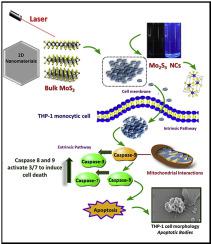当前位置:
X-MOL 学术
›
Mater. Today Chem.
›
论文详情
Our official English website, www.x-mol.net, welcomes your
feedback! (Note: you will need to create a separate account there.)
Neodymium YAG laser chemical vapor deposition growth of luminescent Mo2S3 nanocrystals using bulk MoS2 and its structural, optical properties and caspase-mediated apoptosis in THP-1 monocytic cells
Materials Today Chemistry ( IF 6.7 ) Pub Date : 2020-09-01 , DOI: 10.1016/j.mtchem.2020.100315 S.J. Panchu , S. Dhani , A.A. Chuturgoon , H.C. Swart , M.K. Moodley
Materials Today Chemistry ( IF 6.7 ) Pub Date : 2020-09-01 , DOI: 10.1016/j.mtchem.2020.100315 S.J. Panchu , S. Dhani , A.A. Chuturgoon , H.C. Swart , M.K. Moodley

|
Abstract Metal-sulphur phase-based semiconductor materials are often investigated in the field of nanotechnology. Herein, we describe the synthetic route to obtain Mo2S3 nanocrystals from MoS2 via a laser-furnace technique. These nanocrystals have been tested for cytotoxicity against the monocytic leukemic THP-1 cell line. The synthetic process caused a phase change from MoS2 to Mo2S3 at a temperature of 1100 °C and a pressure of 400 Torr. Powder X-ray diffraction analysis confirmed the crystallinity and structure and X-ray photoelectron spectroscopy confirmed the chemical composition and oxidation states of the Mo2S3 nanocrystals. The morphology of the Mo2S3 has been observed by using field emission scanning electron microscopy and high-resolution transmission electron microscopy. The in vitro cytotoxicity evaluation of the Mo2S3 nanocrystals was determined in the THP-1 cell line. The cytotoxic potential of the Mo2S3 against THP-1 cells was assessed by the WST-1 assay and intracellular caspase activities. The caspase activities were significantly elevated indicating the initiation of both the intrinsic and extrinsic apoptotic pathways when compared to untreated cells. Field emission scanning electron microscopy revealed that the Mo2S3 NCs compromised the cell membrane integrity resulting in a loss of THP-1 cell viability and apoptosis. Thus, Mo2S3 is an aqueous nanocrystal which shows promising cytotoxicity effect against THP-1 with good photoluminescent properties.
中文翻译:

使用块状 MoS2 的发光 Mo2S3 纳米晶体的钕 YAG 激光化学气相沉积生长及其在 THP-1 单核细胞中的结构、光学特性和半胱天冬酶介导的细胞凋亡
摘要 金属硫相基半导体材料是纳米技术领域的研究热点。在此,我们描述了通过激光炉技术从 MoS2 获得 Mo2S3 纳米晶体的合成路线。已经测试了这些纳米晶体对单核细胞白血病 THP-1 细胞系的细胞毒性。合成过程在 1100 °C 的温度和 400 Torr 的压力下导致从 MoS2 到 Mo2S3 的相变。粉末 X 射线衍射分析证实了结晶度和结构,X 射线光电子能谱证实了 Mo2S3 纳米晶体的化学成分和氧化态。使用场发射扫描电子显微镜和高分辨率透射电子显微镜观察了 Mo2S3 的形貌。在 THP-1 细胞系中测定了 Mo2S3 纳米晶体的体外细胞毒性评估。Mo2S3 对 THP-1 细胞的细胞毒性潜力通过 WST-1 测定和细胞内半胱天冬酶活性进行评估。与未处理的细胞相比,半胱天冬酶活性显着升高,表明内在和外在细胞凋亡途径的启动。场发射扫描电子显微镜显示,Mo2S3 NCs 破坏了细胞膜的完整性,导致 THP-1 细胞活力和细胞凋亡的丧失。因此,Mo2S3 是一种水性纳米晶体,对 THP-1 显示出良好的细胞毒性作用,具有良好的光致发光特性。与未处理的细胞相比,半胱天冬酶活性显着升高,表明内在和外在细胞凋亡途径的启动。场发射扫描电子显微镜显示,Mo2S3 NCs 破坏了细胞膜的完整性,导致 THP-1 细胞活力和细胞凋亡的丧失。因此,Mo2S3 是一种水性纳米晶体,对 THP-1 显示出良好的细胞毒性作用,具有良好的光致发光特性。与未处理的细胞相比,半胱天冬酶活性显着升高,表明内在和外在细胞凋亡途径都开始了。场发射扫描电子显微镜显示,Mo2S3 NCs 破坏了细胞膜的完整性,导致 THP-1 细胞活力和细胞凋亡的丧失。因此,Mo2S3 是一种水性纳米晶体,对 THP-1 显示出良好的细胞毒性作用,具有良好的光致发光特性。
更新日期:2020-09-01
中文翻译:

使用块状 MoS2 的发光 Mo2S3 纳米晶体的钕 YAG 激光化学气相沉积生长及其在 THP-1 单核细胞中的结构、光学特性和半胱天冬酶介导的细胞凋亡
摘要 金属硫相基半导体材料是纳米技术领域的研究热点。在此,我们描述了通过激光炉技术从 MoS2 获得 Mo2S3 纳米晶体的合成路线。已经测试了这些纳米晶体对单核细胞白血病 THP-1 细胞系的细胞毒性。合成过程在 1100 °C 的温度和 400 Torr 的压力下导致从 MoS2 到 Mo2S3 的相变。粉末 X 射线衍射分析证实了结晶度和结构,X 射线光电子能谱证实了 Mo2S3 纳米晶体的化学成分和氧化态。使用场发射扫描电子显微镜和高分辨率透射电子显微镜观察了 Mo2S3 的形貌。在 THP-1 细胞系中测定了 Mo2S3 纳米晶体的体外细胞毒性评估。Mo2S3 对 THP-1 细胞的细胞毒性潜力通过 WST-1 测定和细胞内半胱天冬酶活性进行评估。与未处理的细胞相比,半胱天冬酶活性显着升高,表明内在和外在细胞凋亡途径的启动。场发射扫描电子显微镜显示,Mo2S3 NCs 破坏了细胞膜的完整性,导致 THP-1 细胞活力和细胞凋亡的丧失。因此,Mo2S3 是一种水性纳米晶体,对 THP-1 显示出良好的细胞毒性作用,具有良好的光致发光特性。与未处理的细胞相比,半胱天冬酶活性显着升高,表明内在和外在细胞凋亡途径的启动。场发射扫描电子显微镜显示,Mo2S3 NCs 破坏了细胞膜的完整性,导致 THP-1 细胞活力和细胞凋亡的丧失。因此,Mo2S3 是一种水性纳米晶体,对 THP-1 显示出良好的细胞毒性作用,具有良好的光致发光特性。与未处理的细胞相比,半胱天冬酶活性显着升高,表明内在和外在细胞凋亡途径都开始了。场发射扫描电子显微镜显示,Mo2S3 NCs 破坏了细胞膜的完整性,导致 THP-1 细胞活力和细胞凋亡的丧失。因此,Mo2S3 是一种水性纳米晶体,对 THP-1 显示出良好的细胞毒性作用,具有良好的光致发光特性。











































 京公网安备 11010802027423号
京公网安备 11010802027423号